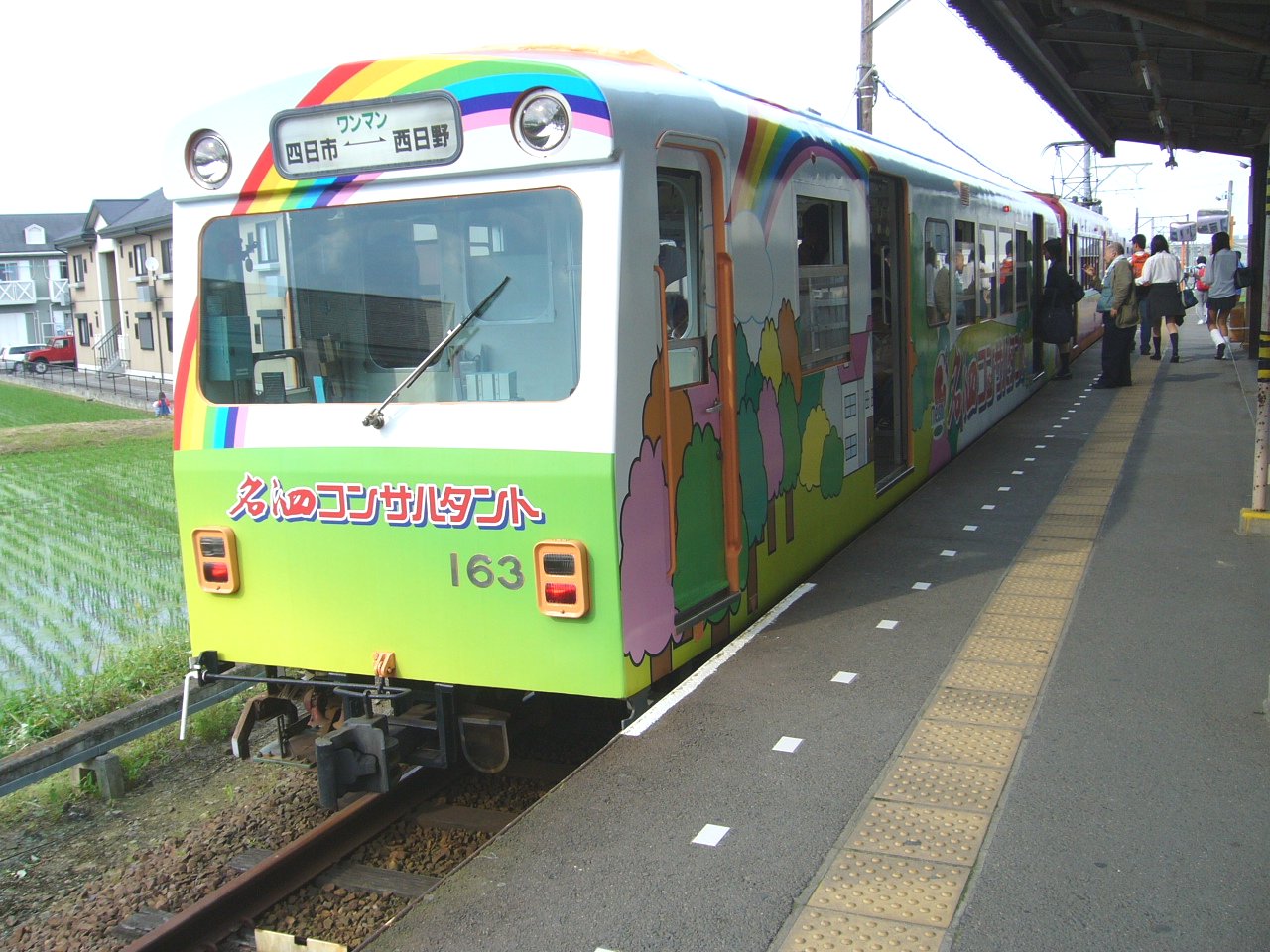- Kintetsu Hachiōji Line
Infobox rail line
box_width = 32em
name = Kintetsu Hachiōji Line
image_width = 300px
caption = Narrow gauge train at Nishihino Station
type = Commuter rail
system =
status =
locale = Yokkaichi,Mie Prefecture
start = ja-stalink|Hinaga
end = ja-stalink|Nishihino
stations = 2
routes =
ridership =
open =Aug 15 ,1912
close =
operator =Kintetsu
character =
stock =
linelength = km to mi|1.3|abbr=yes|precision=1
tracklength =
notrack = 1
gauge = RailGauge|762
el = Overhead, 750V DC
speed =
elevation =
Kintetsu Hachiōji Line diagram
map_show = show|The nihongo|Kintetsu Hachiōji Line|近鉄八王子線|Kintetsu Hachiōji-sen, often called the Kintetsu Nishihino Line (近鉄西日野線 "Kintetsu Nishihino-sen") is a
railway line of the Japanese private railway companyKintetsu , connectingHinaga Station andNishihino Station , both in the city of Yokkaichi,Mie Prefecture ,Japan . With a total length of 1.3 km, it is the shortest of all the Kintetsu train lines.The line connects with the
Kintetsu Utsube Line at Hinaga. Because all trains on the Hachiōji Line offer direct service to Kintetsu-Yokkaichi via the Utsube Line, the two lines are collectively called the Utsube-Hachiōji Line (内部・八王子線 "Utsube-Hachiōji-sen").The line is called the "Hachiōji Line" because it originally ran to Ise-Hachiōji Station, however for many years the endpoint has been Nishihino.
Unlike major Kintetsu lines, the line does not accept
PiTaPa orICOCA which aresmart card ticketing systems.Narrow gauge railway
The line was originally built as a
tram and so the gauge was especially narrow. Later on the line was legally upgraded from a tram to alight rail , however the gauge was not widened as it was on the vast majority of Japan's train lines. Today, there are only four 762 mm gauge train lines in operation in Japan, and the Hachiōji Line is both the oldest and shortest of those four.762 mm railways of Japan
* Kintetsu: Utsube Line (neighboring line)
* Kintetsu: Hachiōji Line (this line)
*Sangi Railway : Hokusei Line (also in northern Mie Prefecture, formerly operated by Kintetsu)
*Kurobe Gorge Railway : Main Line (Kurobe,Toyama Prefecture )History
The Hachiōji Line was built in 1912 and, like the Utsube Line, is one of Kintetsu's oldest train lines. The Hachiōji Line was actually built first, but became a branch line after the original section of what is now the much longer Utsube Line was opened later the same year. Steam engines ran on the line for many years until 1928 when
gasoline -powered trains were introduced, which ran until the line was electrified in 1948.Ownership of the line has shifted a few times during its existence. Mie Tramway built the line but control was given to
Mie Railway ("Santetsu") shortly after in 1916. Then in 1944, Santetsu, along with six other companies, merged to form Mie Transport ("Sanco"). Twenty years later, the railway department of Sanco split off to become a separate company called Mie Electric Railway ("Sanden"), however this organization was short-lived as it was bought up by railway giant Kinki Nippon Railway ("Kintetsu") the following year, and thus in 1965 the line came under its current name and ownership.
=Flood daAs the line's official name indicates, ja-stalink|Nishihino is not the original terminus. When the line was built it was 2.8 kilometers in length and extended past Nishihino and terminated in Yokkaichi's Hachiōji neighborhood and for over 60 years, trains went all the way to Ise-Hachiōji Station. However, in 1974, there was an especially heavy rainstorm that flooded the Tempaku River which runs right alongside the line. The track suffered from severe water damage and the entire line was temporarily shutdown for repairs. Although the reason is not clear, the track was only repaired as far as Nishihino and the rest of the line was abandoned. The remainder of the line, only 1.3 kilometers long, was reopened in 1976.
Because so many years have passed since the endpoint was changed to Nishihino, younger generations primarily refer to the line as the Nishihino Line, a name that is even used by some Kintetsu train conductors. It is possible the line's name will be officially changed in the upcoming years.
Timeline
*
Aug 15 ,1912 - Hinaga ~ Ise-Hachiōji sections opens (Mie Tramway).
*Jul 19 ,1916 - Control of line is transferred toMie Railway ("Santetsu").
*Dec 01 ,1916 - Based on train-related laws, the line's classification is officially changed from a tram to a light railway.
*Mar 01 ,1928 - Gasoline-powered trains introduced.
*Feb 11 ,1944 - Santetsu and six other companies merge to form Mie Transport ("Sanco"). Line becomes part of the Sanco Mie Line.
*Sep 10 ,1948 - Entire line electrified.
*Feb 01 ,1964 - Sanco railway division splits off and forms a new company named Mie Electric Railway ("Sanden").
*Apr 01 ,1965 - Sanden, and all of its lines, are acquired by Kinki Nippon Railway ("Kintetsu"). Line officially renamed Kintetsu Hachiōji Line.
*Jul 25 ,1974 - Operation on entire line is suspended due to water damage.
*Apr 01 ,1976 - After repairs, Hinaga ~ Nishihino section reopens. Nishihino ~ Ise-Hachiōji permanently closes.ervices
LO Local (普通 "futsū"): For ja-stalink|Kintetsu Yokkaichi|Yokkaichi: For ja-stalink|Nishihino:Locals stop at every station.:All trains offer conductor-less ("One-man") service.:Trains run twice per hour in both directions.
tations
References
* [http://www.kintetsu.jp/kouhou/Rireki/A40018.html Kintetsu Line Archives - Hachiōji Line]
* Wikipedia - Kintetsu Hachiōji LineExternal links
* [http://www.kintetsu.co.jp/foreign/english/useful/route_map/railway2.html#2 Kintetsu railway network map - Hachiōji Line]
* [http://hisaai.hp.infoseek.co.jp/Kintetsu/na/Ub_s_eg.html#h Hisakyu - Kintetsu Hachiōji Line]
* [http://express5.hp.infoseek.co.jp/kinutube.htm Main Terminal - Kintetsu Hachiōji Line]
Wikimedia Foundation. 2010.
